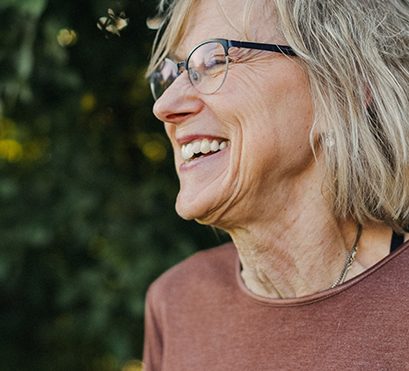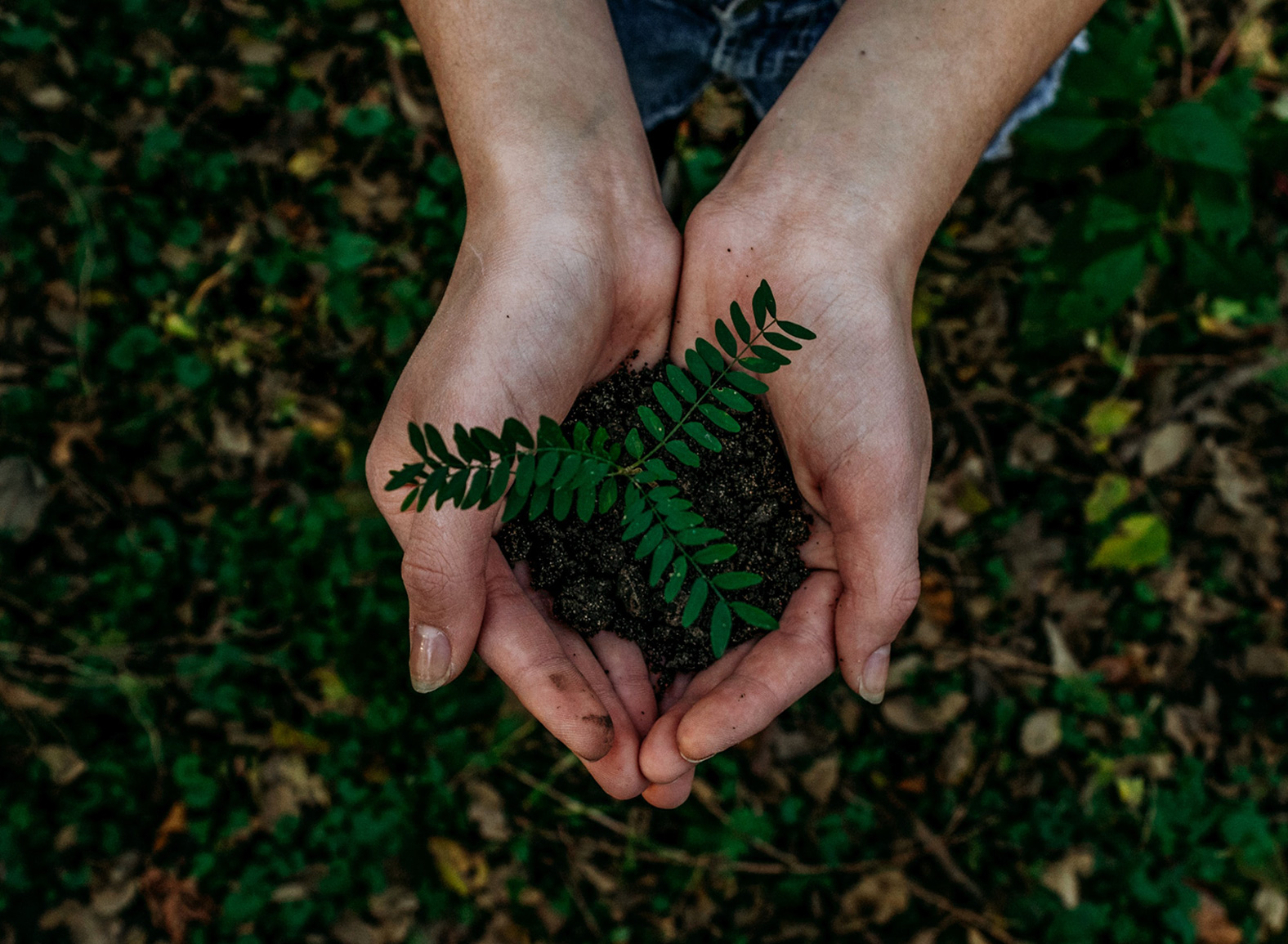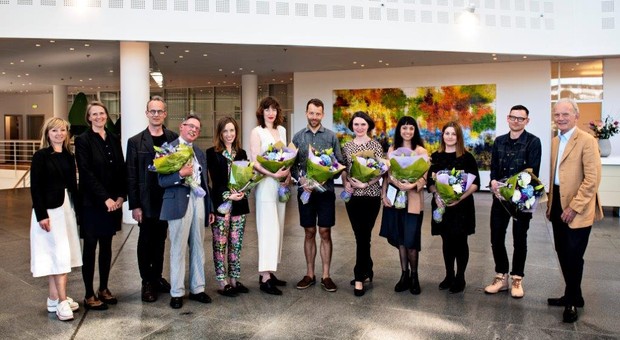On Monday, 7 May, the Novo Nordisk Foundation presented scholarships, fellowships and grants within art research to 11 talented art researchers. The event took place at the yearly art fellowship award celebration at the Foundation, at which the recipients, their families, friends and collaborators were invited to participate.
In March, the Foundation awarded five Mads Øvlisen PhD-scholarships, four Mads Øvlisen postdoctoral fellowships and two Investigator Grants in art history research. The Foundation’s Board awarded the grants based on applications received in open competition and evaluated by the Committee on Research in Art and Art History.
The Chair of the Committee, Jacob Wamberg, and committee members Sanne Kofod Olsen and Mads Øvlisen, gave speeches and presented flowers and diplomas to each recipient.
About 50 guests participated in the celebration, and 8 of the 11 recipients gave a short presentation of their coming research projects.
Below you can read more about the researchers and their projects.
THE ELEVEN RECIPIENTS AND THEIR RESEARCH PROJECTS
MADS ØVLISEN PHD-SCHOLARSHIPS (5):

Lise Hindsberg, MA
Age: 28 years
Grant: Mads Øvlisen PhD-scholarship – art history before 1900
Project title: The Imaginary Resonance and the Transmission of Enargeia into the Image Theory and Image Practice of the Renaissance
Abstract: The PhD project investigates the transmission of enargeia from the Progymnasmata and the rhetorical treatises of Antiquity to the image theory and image practice of the Italian Renaissance. It researches into the image as a simulacrum of perception, elucidated through the imaginary resonance; the presence of invisible music in the interplay between vivid representation of music-making angels and the viewer’s memory and imagination. It is an image anthropological research into how the angel orchestras contributed to the illusion of the vividness of the image, what effect music had because of this illusion, and the dialectics between absence/presence and silence/sound.
Institution: University of Copenhagen, Department of Arts and Cultural Studies
Aliya Say, MA in History and Business of Art and Collecting
Age: 30 years
Grant: Mads Øvlisen PhD-scholarship – art history after 1900
Project title: Art, Humans, and Plants: On Corporeal Experience in the Anthropocene
Abstract: The plant is a collective being, with its body described by Michael Marder as a rhizome that ceaselessly establishes connections. The rhizomatic life of plants provides a useful counterpoint to a notion of life housed within individual organisms, offering instead a space of distributed intelligence and conviviality.
Thinking like a plant is thinking without identity – it is a continuous celebration of the restlessness of life, of movement, dynamic extension, and temporality. My project aims to account for the history of human engagement with the vegetal model of thought and vibrant materiality in art and literature since 1945, a proposed start of the Anthropocene era. Primarily, the project is concerned with a critical investigation of the body, the senses and the new material turn in contemporary art expressed through dance and performance, immersive installations and multisensory experiences.
Institution: Aarhus University, School of Communication and Culture
Christian Danielewitz , MFA, visual artist
Age: 39 years
Grant: Mads Øvlisen PhD-scholarship – practice-based art
Project title: Hidden Flow: the Production of Invisible Territories in the Age of Digital Visibility
Abstract: My research proposal addresses the relation between environmental devastation and the material production of our mineral-based image technologies. The overall point of departure is a particular aspect of impact: that is, the contamination of human and natural environments caused by toxic disposal facilities of mineral waste, also known as hidden flow. The theoretical framework for my research proposal is informed by a redefinition of the relation between the map (generated by the image technologies), and the territory (the contaminated zones of extraction and waste), and the purpose is to visualize this relation as a material causality, in which the territory is produced, in a physical sense, by the map, or rather, by the technological foundation of the map.
Institutions: Royal Danish Academy of Fine Arts and University of Copenhagen

David Hilmer Rex, MFA, visual artist
Age: 32 years
Grant: Mads Øvlisen PhD-scholarship – practice-based curating
Project title: Artistic Practice and Systems Change
Abstract: The purpose of this PhD project will be to realize a set of new activities in relation to Primer, a platform for artistic and organizational development, housed in the context of Aquaporin, a global water technology company. The main objective is to explore and consolidate the roles, functions and activities of an art-based research and development department housed in a research-driven technology company. What might result if we renew relations between artistic, scientific, technological and business practices?
Institutions: Royal Danish Academy of Fine Arts and Aarhus University

Helene Nymann, MFA, visual artist
Age: 36 years
Grant: Mads Øvlisen PhD-scholarship with an extraordinary potential – practice-based art
Project title: Memories of Sustainable Futures: Remembering in the Digital Age
Abstract: The research project endeavours to create and analyse new artworks that address the shift in our relation to and perception of memories – both human and non-human. I will employ mnemonic devices as an artistic method to deepen our understanding of the relational functions of memory, investigating the possible connections and exchanges between cultures of remembrance, ecosystems and brain-computer interfaces. This triangulation will lead to the creation of dynamic thought-spaces (Denkräume) that stimulate new ways of thinking and imagining alternative methods of how to remember and navigate our way towards more sustainable development in the age of rapid technological change.
Institution: Aarhus University, School of Communication and Culture
MADS ØVLISEN POSTDOCTORAL FELLOWSHIPS (4):

Kerry Greaves, PhD, postdoctoral fellow
Age: 41 years
Grant: Mads Øvlisen postdoctoral fellowship – art history
Project title: Otherwise: Women Artists in Denmark, 1920-1955
Abstract: The project will retrace and assess the critical reception, aesthetic contributions and cultural and political context of important women artists and collectors active in Denmark from the period between World War I through immediately -World War II.
Rather than proclaiming an alternative canon of “rediscovered” women artists, the project seeks to address the paradigms that marginalized women artists and their work in the first place, while suggesting different means through which to configure women’s art histories otherwise. The purpose is to foreground and re-evaluate the complex relationship between modern art and women art professionals within modernism in Denmark.
Institution: University of Copenhagen, Department of Arts and Cultural Studies

Ruth Noyes, PhD, Assistant Professor
Age: 40 years
Grant: Mads Øvlisen postdoctoral fellowship – art history
Project title: Blood & Fire/Ray & Curve: Engraving, Etching, and Imprinting Knowing in the Age of Tycho and Galileo
Abstract: Today we take for granted that “true” scientific innovation has a visual language all its own, and that this language has a history. My project tracks the early modern origins of the aesthetic history of scientific truth claims to the production and circulation of engraved, etched and otherwise printed images, objects and materials within and between the north-south ambits of Tycho Brahe and Galileo Galilei. I investigate how the manufacture of new ways of knowing about unseen phenomena in the universe was the invention of the self-professed truthful aesthetics of “ingenious imprints”, and of their movement through cross-cultural Tychonic-Galilean networks.
Institution: National Museum of Denmark

Daniela Agostinho, PhD, postdoctoral fellow
Age: 32 years
Grant: Mads Øvlisen postdoctoral fellowship – practice-based art
Project title: Archival Encounters: towards an Ethics of Care in Curatorial Practice
Abstract: This project is concerned with the necessity and possibility of inventing a new relationship to the colonial image archive. It posits that the digitization and digital display of colonial imagery demands a critical rethinking of curatorial practice that recasts questions of access, temporality and care. The project advances the notion of “archival encounter” in order to foreground the need to refocus curatorial practice on the ethical encounter between colonial images and contemporary viewing communities. This “archival encounter” lies at the centre of a practice of “curatorial care”, a mode of engagement with the colonial image archive that privileges the intersubjective relations between documented and viewing subjects. The goal of the project is thus twofold:
1) to advance theoretical knowledge on the affective and ethical implications of encountering colonial images in contemporary viewing contexts; and
2) to formulate curatorial strategies that acknowledge and reinscribe the subjectivities wounded by the colonial archive in ways that do justice to the represented subjects and communities of looking.
Institution: University of Copenhagen, Department of Arts and Cultural Studies
Dehlia Hannah, PhD
Age: 40 years
Grant: Mads Øvlisen postdoctoral fellowship – art & natural sciences
Project title: The Imaginary Museum of Philosophical Monsters
Abstract: An Imaginary Museum of Philosophical Monsters examines how fictional creatures are used in philosophy, the arts and the natural sciences to mark the limits of human understanding and provoke new ways of imagining the order of nature.
Philosophers and scientists depend upon an array of imaginary creatures, places and things to exemplify arguments, clarify reasoning and experiment upon in thought-demons, invisible hands, bats, cats, and brains in vats, imaginary worlds and hypothetical persons. These exemplary cases are collected here under the name of philosophical monsters. The impulse to catalogue these monsters will translate into a digital bestiary, an exhibition of historical images and newly commissioned artworks and a monograph exploring how we reason through examples.
Institution: Aalborg University, Center for Bioscience and Technoanthropology
INVESTIGATOR GRANT IN ART HISTORY RESEARCH (2):

Mikkel Bolt, Associate Professor, PhD
Age: 45 years
Grant: Investigator Grant in art history research
Project title: Aesthetic Protest Cultures: the Avant-Garde after the Avant-Garde
Abstract: Aesthetic Protest Cultures: The Avant-Garde after the Avant-Garde is a collective research project analysing what happened to the artistic avant-garde after the so-called death of the avant-garde in the late 1960s. Within art history, it is customary to argue that the avant-garde disappeared after World War II, or, had its last gasp in the 1960s. This research project will propose a new reading of the development of the avant-garde, arguing that the avant-garde perspective found its way into protest culture and political activism. Our empirical material consists of three specific protest cultures, spanning the period from 1968 until the late 1990s: Autonomia Creativa in Italy in the 1970s, the alter-globalization movement in the late 1990s and the contemporary square occupation movement in southern Europe and the United States. The project will embed the three case-specific analyses in a broader historical investigation of the relation between art and politics after 1968, contributing to a new understanding of the role of collective protests and the aesthetic dimension of politics today, arguing that collective protests constitute a continuation of the artistic avant-garde project outside the art institution.
Institution: University of Copenhagen, Department of Arts and Cultural Studies

Chris Fischer, Senior Researcher
Age: 67 years
Grant: Investigator Grant in art history research
Project title: Fra Bartolommeo. Painter and Draughtsman
Abstract: The Dominican friar and painter Fra Bartolommeo (Florence, Italy 1473-1517) is one of the four founding fathers of the High Renaissance style. We know around 100 paintings and more than 1500 drawings by him, the largest number of drawings that have survived by a Renaissance artist. They allow us to follow his working process in all details. The latest monograph was written in 1922. It is mainly a formal analysis of his work and not satisfactory according to modern standards, so I wish to write a new monograph based on a catalogue raisonné of all the paintings and drawings. The book will follow three tracks: a delineation of his work process; a scrutiny of the patrons and their influence on the iconography of his paintings and a; study of the ways in which his works and the High Renaissance style became known in Rome, northern Italy and Europe.
Institution: National Gallery of Denmark








